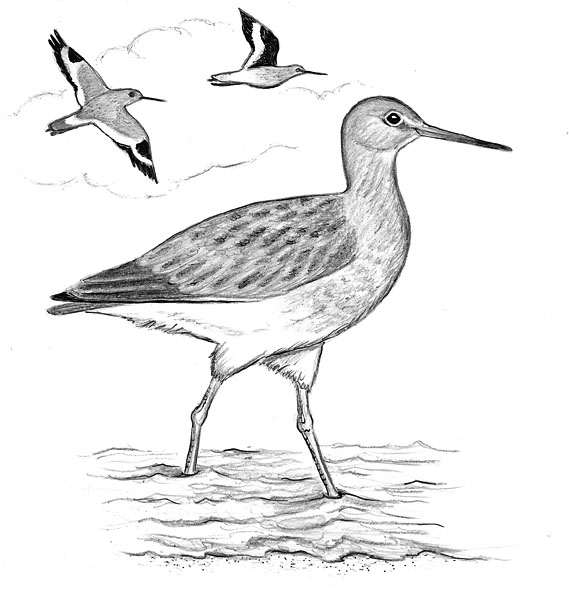
Dear Bird Folks,
I was walking along the beach in Plymouth (MA) last Saturday night when I saw a strange bird fly by. I didn’t have my binoculars, so the best description I can give you is that the bird looked like a giant mockingbird. It was gray, like a mockingbird, plus it had mockingbird style white patches on its wings as it flew. But this was no mocker. This bird was huge. Any thoughts?
– Pam, Duxbury, MA
I was afraid of this, Pam,
Ever since they built that nuclear power plant, I feared the day would come when giant birds would start appearing in the Plymouth area. Frankly, I’m amazed it has taken so long. However, I’m surprised that the first super-sized bird is a mockingbird. I always imagined that a robin would be the first bird to go huge. Robins always appear as if they are too big for their bodies. Their big barrel chest makes them look like a bird that is waiting to explode into something far larger. Oh well, I guess if we have to deal with a race of monster birds they might as well be mockingbirds. As you know, mockingbirds are multilingual. That will be helpful if we have to exchange words with their leaders. When it comes to dealing with giant birds, it’s good to keep the lines of communication open.
While I can’t be sure, I’d be willing to bet the giant mocker you saw was a “Willet.” Willets are large, gray, robust birds that weigh nearly five times as much as a mockingbird does. When they fly Willets exhibit bright white patches on their wings, much like mockingbirds do. It’s quite possible that from a distance, without binoculars and after a little too much of a good time on a Saturday night, a flying Willet could perhaps look like a giant flying mockingbird. It’s okay, Pam. There’s nothing to be ashamed of. I’ve had plenty of those Saturday nights myself, especially in Plymouth.
Willets are shorebirds. (You did say you saw this bird on the beach, right?) Shorebirds come in all shapes and sizes. Some shorebirds are active feeders, like the little Sanderlings we see sprinting along the water’s edge. There are colorful shorebirds, too, such as Ruddy Turnstones and Red Knots. Then there are the godwits and curlews, tall statuesque birds with long, graceful bills. Willets are nothing like those birds, not even close. Their claim to fame is being one of the blandest of all shorebirds. This bird’s overall coloring is drab gray-brown, looking like a chunk of dirty fog with legs. Most of the time Willets are found all alone, standing motionless on the beach, as if they are waiting for a bus that never comes. Even when feeding they can be fairly sluggish. Eating appears to be more trouble than it’s worth to them. Only when they fly, and expose their white wing-patches, do Willets have any color at all. And even then, according to some, they still don’t look much like shorebirds, but like giant mockingbirds.
Willets spend most of the year being inconspicuous but that all changes when the breeding season rolls around. Courting and territory defense turn these generic birds into aggressive, noisy showoffs. Flashing their white wing-patches and screaming their loud, namesake “pill-will-willet” song, a Willet couple will defend their territory against all comers. Springing into the air the birds will actually engage intruding Willets in aerial dogfights. (I’m not sure why it’s called a “dogfight.” Dogs can’t fly, except for Underdog and I’m not 100% certain that he is even real.) And if the encroaching bird opts to duke it out on land, things may become even more violent. Using their strong beaks Willets will pin an intruder’s neck to the ground, sometimes keeping it there for several minutes until the pinned bird either taps out or says “uncle.” Defending birds also have the odd habit of trying to pluck the feathers out of a trespasser’s tail, which is the ultimate humiliation. Good luck to any tail-less Willet that tries to attract a mate. It’s not going to happen.
One of the reasons Willets defend each other so aggressively is because they have strong partner fidelity. That’s right, they mate for life (how sweet). Willets have figured out something that many other bird species don’t seem to understand. Since they all look pretty much the same, it makes little sense to shop around. If they switch mates the best they can hope for is an exact duplicate of what they just had, or worse, a mate with no tail feathers.
Willets are a bit of a success story. During the dark days of market gunning, their population was all but obliterated. But they have been slowly coming back. Even as plovers and terns grab all the headlines, the Cape Cod Willet population has quietly gone from zero breeding pairs in the mid-70s to several dozen today, with many more found in other parts of coastal Massachusetts. If Willets aren’t nesting in Plymouth already, I’ll bet they will be soon. You should not be surprised to see one on a Saturday night or any other time during the summer. While I can’t be positive the bird you saw was a Willet, Pam, I’m positive it wasn’t a giant mockingbird. They have all been eaten by the giant robins.